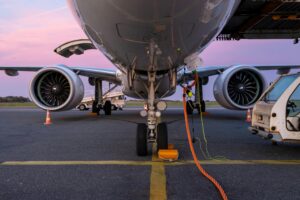In the past five years, Nigeria’s aviation sector has faced a staggering 516 wildlife strikes across 20 airports, a figure that underscores a significant and often under-discussed challenge to the industry. These incidents, primarily involving bird strikes but also collisions with larger animals like antelopes, have disrupted operations, damaged aircraft, and imposed substantial financial burdens on airlines. While the data referenced in the Independent article covers up to 2023, the issue remains a critical concern for Nigeria’s aviation ecosystem. This article explores the financial impact of these wildlife strikes on Nigerian airlines, compares Nigeria’s experience with other countries, and proposes strategies to mitigate this growing menace.
Financial Impact on Nigerian Airlines
Wildlife strikes, particularly bird strikes, are a costly affair for airlines, with financial implications stemming from aircraft repairs, flight disruptions, and passenger compensation. The Independent article cites a 2022 estimate by the Airline Operators of Nigeria (AON), stating that Nigerian airlines lose over N20 billion (approximately $60 million USD at the time) annually due to bird strikes alone. More recent estimates from 2025, as reported by Economic Confidential, suggest annual losses of around N3 billion (approximately $2 million USD at current exchange rates) specifically for engine replacements due to bird strikes. These figures, while varying due to exchange rate fluctuations and differing methodologies, highlight the significant economic toll on an already strained industry.
The financial impact can be broken down into several components:
1. Direct Repair Costs: Bird strikes often damage critical aircraft components, particularly engines, which can cost upwards of $1 million to replace, depending on the aircraft model. For instance, Air Peace, Nigeria’s largest carrier, reported 43 bird strikes in 2024, a threefold increase from 14 in 2021, leading to substantial maintenance costs. Grounded aircraft, such as the three Air Peace planes affected within 48 hours in 2025, further exacerbate losses by reducing operational capacity.
2. Operational Disruptions: Wildlife strikes frequently cause flight delays and cancellations, as seen in the case of an Air Peace flight aborted in Abuja due to a bird strike before takeoff. These disruptions lead to lost revenue, as airlines must refund passengers or rebook them, often at additional cost. The Nigerian Civil Aviation Authority (NCAA) mandates that airlines provide care during such disruptions, adding to operational expenses.
3. Indirect Costs: Customer dissatisfaction and loss of confidence due to frequent delays and cancellations can erode brand loyalty, particularly in a competitive market. Additionally, insurance premiums may rise as insurers factor in the high frequency of wildlife strikes in Nigeria, further straining airline budgets.
Given the 516 wildlife strikes reported from 2018 to 2023, and assuming a conservative average cost of $500,000 per incident (covering repairs, delays, and compensation), the cumulative financial impact over five years could exceed $250 million USD. This estimate aligns with global figures, where bird strikes alone cost the aviation industry $1.2–$1.36 billion annually, as noted by experts like John Allan, former chairman of the International Bird Strike Committee.
Comparison with Other Countries
Wildlife strikes are a global phenomenon, but Nigeria’s high incidence rate stands out. Between 2018 and 2023, Nigeria recorded 516 strikes across 20 airports, averaging roughly 103 strikes per year. In contrast, the United States, with a far larger aviation sector, reported 10,726 wildlife strikes in 2012 alone, according to the Federal Aviation Administration (FAA). However, the U.S. operates thousands of daily flights across hundreds of airports, making its per-flight strike rate significantly lower. The UK, with a more comparable aviation market size, reported 2,215 bird strikes in 2012, suggesting a lower incidence rate than Nigeria relative to air traffic volume.
The financial impact also varies. In the U.S., annual losses from bird strikes are estimated at $650 million, but this is spread across a much larger industry with greater resources. Nigeria’s losses, while smaller in absolute terms, are disproportionately burdensome given the financial fragility of its airlines, many of which operate older fleets (averaging 20 years, compared to Ethiopian Airlines’ five-year average) and face additional challenges like fuel shortages and currency repatriation issues.
Other countries have implemented robust mitigation strategies that Nigeria can learn from. Singapore’s Changi Airport, for instance, employs a 12-member wildlife management team that conducts daily patrols and uses distress calls and anti-perching devices to deter birds. The U.S. has stringent regulations requiring airports to conduct wildlife hazard assessments and implement control measures, such as habitat modification and the use of radar-based bird detection systems. These proactive approaches contrast with Nigeria’s reactive measures, where equipment like “Phonic Bird Wailers” and ICAO-supplied wildlife control tools have been deployed but not consistently utilized due to insufficient trained personnel.
Challenges Specific to Nigeria
Nigeria’s high wildlife strike rate is driven by several factors:
- Geographical and Environmental Factors: Many Nigerian airports, such as Murtala Muhammed Airport (MMA) in Lagos, are located near grasslands or water bodies that attract birds and wildlife. MMA alone accounted for 58 of the 93 bird strikes recorded in the first half of 2022, highlighting its status as a high-risk area.
- Infrastructure Deficiencies: The Independent article notes that inadequate wildlife management infrastructure and a lack of skilled manpower exacerbate the problem. The Federal Airports Authority of Nigeria (FAAN) has been criticized for not adopting modern technologies or forensic approaches to identify and deter specific bird species.
- Operational Practices: Some pilots contribute to the issue by disregarding Air Traffic Controller (ATC) instructions, rushing takeoffs or landings when birds are active. This was noted by Azike Edozie, NCAA’s Head of Bird/Wildlife Hazard Control, who emphasized that 98% of strikes occur during takeoff or landing.
- Economic Constraints: Nigeria’s aviation sector faces broader challenges, including high operating costs, foreign exchange shortages, and an aging fleet, which limit airlines’ ability to absorb the financial shock of wildlife strikes or invest in preventive measures.
Strategies to Reduce Wildlife Strikes
To alleviate the burden of wildlife strikes, Nigeria must adopt a multi-faceted approach, drawing on international best practices while addressing local challenges:
1. Enhanced Wildlife Management Programs: FAAN should establish dedicated wildlife management teams at high-risk airports like MMA, modeled after Singapore’s Changi Airport. These teams should conduct regular patrols, use advanced technologies like bird detection radar, and employ non-lethal deterrents such as distress calls, lasers, and pyrotechnics. The recent acquisition of equipment from Canada and ICAO is a step forward, but effective utilization requires trained personnel.
2. Habitat Modification: Airports should modify surrounding environments to reduce attractions for birds and wildlife. This includes clearing vegetation, managing waste to eliminate food sources, and draining nearby water bodies. Collaboration with local communities and property owners, as initiated by FAAN at MMA, can help identify and mitigate attractants.
3. Pilot and ATC Coordination: The NCAA should enforce stricter compliance with ATC instructions and provide training to pilots on wildlife strike risks. Real-time communication between ATCs and pilots can help delay takeoffs or landings when birds are detected.
4. Insurance and Cost-Sharing Models: Stakeholders like Amos Akpan have advocated for shared insurance models where FAAN and airlines jointly cover the costs of wildlife strike damages. This could incentivize FAAN to prioritize prevention while easing the financial burden on airlines.
5. Investment in Training and Technology: The Nigerian College of Aviation Technology (NCAT) in Zaria should expand training programs for wildlife management specialists. Additionally, investing in forensic ornithology to study local bird species and their behaviors can inform targeted mitigation strategies.
6. Regulatory Oversight: The NCAA should strengthen enforcement of regulations, such as fining airport operators for preventable strikes. Regular audits and wildlife hazard assessments, aligned with ICAO standards, can ensure accountability.
The Path Forward?
The 516 wildlife strikes reported in Nigeria from 2018 to 2023 represent a significant challenge to the aviation industry, with financial losses likely exceeding $250 million over five years. Compared to countries like the U.S. and Singapore, Nigeria’s high strike rate and limited mitigation efforts highlight the need for urgent action. By adopting international best practices, enhancing training, and fostering collaboration among stakeholders, Nigeria can reduce the incidence of wildlife strikes, ensuring safer skies and a more resilient aviation sector. The path forward requires not just investment in equipment but a cultural shift toward proactive safety management—a necessity for an industry critical to Nigeria’s economic growth.
Disclaimer: The insights shared in this article are for informational purposes only and do not constitute strategic advice. Aviation markets and circumstances vary, and decisions should be based on your organization’s specific context. For tailored consultancy and guidance, please contact info@avaerocapital.com.




